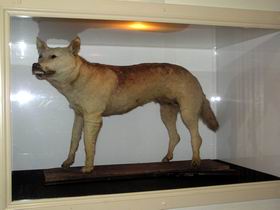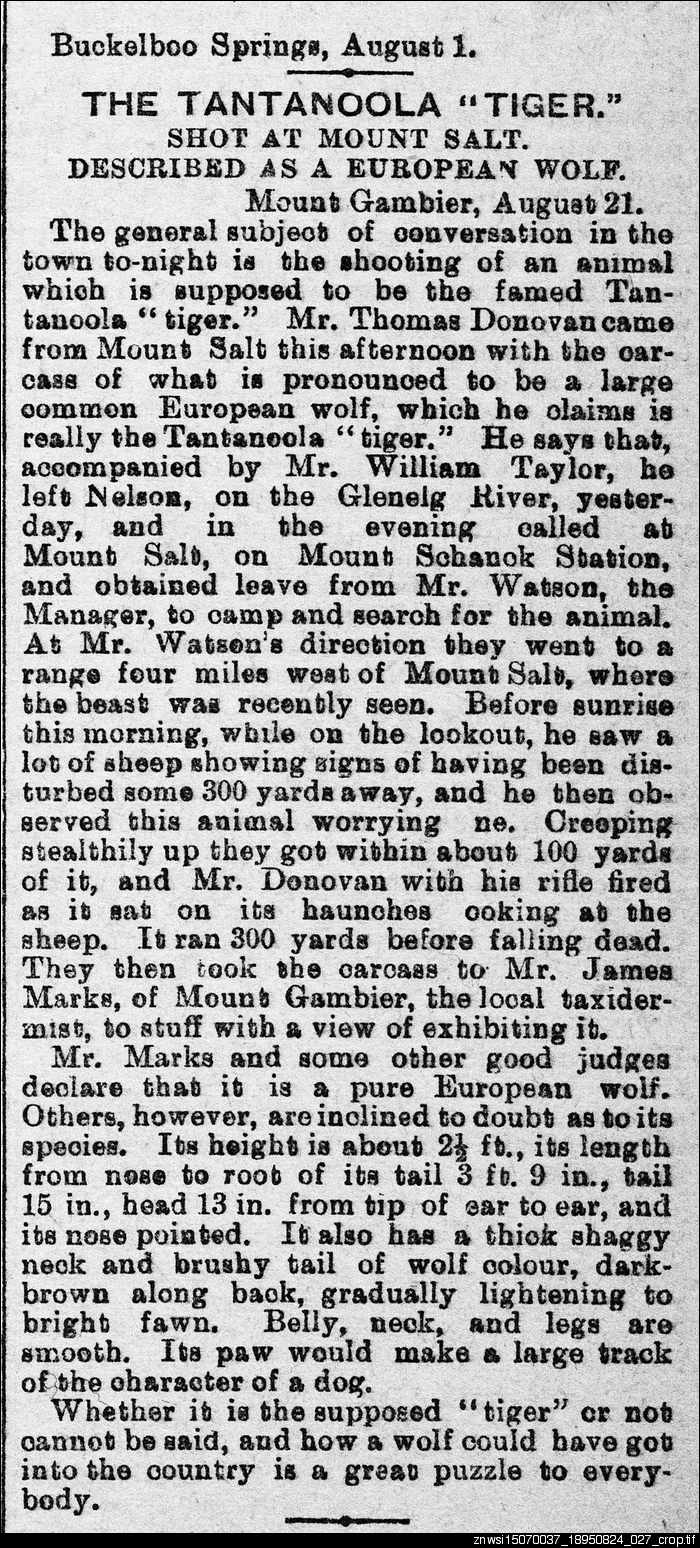Thylacine In Tantanoola Tiger Terra?
Posted by: Loren Coleman on June 4th, 2009
There seems to be a little cryptozoological enigma waiting to be more deeply examined in Australia, complete with a taxidermy mystery mount and a new nearby sighting of a possible Thylacine.

Ever hear of the Tantanoola Tiger?

Donovans is a town located on the Glenelg River in South Australia, Australia. It is in the Hundred of Caroline and the County of Grey. Its Local Government Authority is the District Council of Grant.
The area was originally known as Donovans Landing, and was owned by Thomas John Donovan. The area was subdivided in 1947. Thomas John Donovan gained fame as the person who shot the Tantanoola Tiger.
The Tantanoola Tiger is a phantom cat which supposedly stalked the area during the late nineteenth century. One story goes that in 1884 near Tantanoola in South Australia’s south east a Bengal tiger supposedly escaped from a travelling circus (well, we’ve all heard that one before). A search was mounted, but the tiger was never found.

Adelaide Observer, 24 August 1895, p. 27
Over the next few years, there were many reports of missing sheep (some say 4000) in the area and folks suggested that the sheep had become the prey of the missing tiger. Eleven years after the tiger went missing, in August 1895, the prominent local resident Thomas John Donovan, saw what he thought was the Bengal tiger in a paddock with a sheep in its jaws. He took a shot at it with his gun and shot the animal in the side. As it turns out, it was not a Bengal tiger, but a Eurasian wolf – equally out of place in the Australian environment.
The State Library of Australia has the Tantanoola Tiger mount, shown in a photograph from 1947 .
The animal was determined to be an “Assyrian wolf,” (species?) although how it arrived in South Australia has been the subject of a number of theories. One of those, for example, said that the wolf was a stowaway on a boat that was shipwrecked off the coast, but managed to make it to the shore.
The Tantanoola Tiger is currently preserved and on display at the Tantanoola Hotel (which is also known colloquially as the “Tantanoola Tiger Hotel”). Various images of that taxidermy mount are on this page.

Perhaps, like the Shunka Warak’in, it is time for a DNA sample of the Tantanoola Tiger to be taken to determine what it is.
In terms of popular culture, the animal is better known in Australia, of course, than North America. Australian poet Max Harris wrote a poem titled “The Tantanoola Tiger,” which is included in the collection The Angry Penguin: the Poetry of Max Harris, published by the National Library of Australia.
(For fifteen years after the shooting of the Tantanoola Tiger, sheep continued to go missing from the area. Some felt there was a human element to the ongoing problem. A policeman from Adelaide eventually went to investigate and arrested a local man for sheep stealing. How the two were interrelated is still not clear.)
Now comes news of a new sighting in the area.
A Donovans man says he saw an animal on Monday afternoon [June 1, 2009] that resembled a Tasmanian tiger.
Richard Elliott was driving along Dry Creek Road toward Princess Margaret Rose Cave when he observed the mystery animal near a pine plantation about 3.30pm.
“At first I thought it was a fox, but it was too long and gangly,” Mr Elliott said.
“It had a long tail; it definitely wasn’t a fox.”
Mr Elliott said the animal was definitely not a dog or a cat either.
It moved into the bush too quickly for him to determine if it had stripes.
Mr Elliott said the animal was long and skinny, with exposed ribs.
The Tasmanian tiger, or Thylacine, is believed to have become extinct when a captured animal died in 1936.
There have been no officially verified sightings of a Thylacine in mainland Australia, but many unconfirmed sightings have been reported in the South East of South Australia, Western Victoria and South Gippsland.
Source: “Tasmanian tiger sighting claimed,” The Border Watch.
About Loren Coleman
Loren Coleman is one of the world’s leading cryptozoologists, some say “the” leading living cryptozoologist. Certainly, he is acknowledged as the current living American researcher and writer who has most popularized cryptozoology in the late 20th and early 21st centuries.
Starting his fieldwork and investigations in 1960, after traveling and trekking extensively in pursuit of cryptozoological mysteries, Coleman began writing to share his experiences in 1969. An honorary member of Ivan T. Sanderson’s Society for the Investigation of the Unexplained in the 1970s, Coleman has been bestowed with similar honorary memberships of the North Idaho College Cryptozoology Club in 1983, and in subsequent years, that of the British Columbia Scientific Cryptozoology Club, CryptoSafari International, and other international organizations. He was also a Life Member and Benefactor of the International Society of Cryptozoology (now-defunct).
Loren Coleman’s daily blog, as a member of the Cryptomundo Team, served as an ongoing avenue of communication for the ever-growing body of cryptozoo news from 2005 through 2013. He returned as an infrequent contributor beginning Halloween week of 2015.
Coleman is the founder in 2003, and current director of the International Cryptozoology Museum in Portland, Maine.










I would think an Australian taxidermist would be able to tell the difference between a placental mammal and a marsupial. But then, I don’t see how a wolf could be mistaken for a Bengal tiger, either, at least by anyone who actually saw the wolf. Finally, rats stow away on ships, and probably house cats as well, but a wolf? It’s hard to imagine it sneaking aboard a ship, and even harder to imagine that it would not be discovered and killed — unless it were brought aboard deliberately.
Why is it not simply a dingo, a subspecies of the wolf?
Maybe it’s just a really bad taxidermy mount, but one thing that definitely does NOT look like is a wolf. Looks a lot like a dingo, but surely an Australian taxidermist would know if it was a dingo. Maybe it’s a German or Belgian Shepherd Dog or a dingo cross . But it sure doesn’t look like a European wolf.
This seems silly. I agree with all responses so far. For all we know it could be a simple mutt that was someones pet or it’s offspring.
It wouldn’t shock me at all if we found out it’s got some kind of common dog in it and who’s to say sightings of a Thylacine aren’t a mutts from a mutt that mated with one of the last tigers alive at the time.
Just something to think about.
It looks remarkably similar to a Dingo.
Here’s my thought: Dingo mix and bad taxidermy job.
Before people get carried away, several obvious things must be mentioned:
Marsupials do not mate with placental mammals.
The reported Bengal tiger escapee apparently was not the wolf-like animal killed in 1895.
Thylacines are marsupial mammals.
Wolves, dingos, and dogs are placental mammals.
What an animal looks like as a taxidermy mount may not be a good indicator of affinities, whether a placental or a marsupial mammal.
Good post, Loren!!!
Good “sighing,” too!!!
I agree the stuffed “tiger” could be a bad taxidermy job. 🙂
Thomas “Fos” Donovan shot the Tantanoola Tiger on August 21, 1895. The carcase was stuffed “lacquered a little around around the gums to give a savage look” and displayed in a glass showcase at the Tiger Hotel in Tantanoola.
In the 1957 a 90 year old man Alf Warman of Adelaide South Australia visited the hotel. When he saw the stuffed tiger he exclaimed “that’s my dog”.
He explained how he had come to be the owner of the beast that had terrified the district more than 60 years before.
Alf Warman was a young survey worker in the growing colony and was given by his brother a puppy, the offsping of a female European Deer Hound mated with a Blood Hound.
As the pup grew Alf found him too large and hungry to keep at his Norwood (a suburb of Adelaide) home so he was sent to relatives of Norwood’s mayor in the south east of the state to help kill wild dogs.
Reports of the “tiger” then began.
Source – Walkabout June 1968.
nice alliteration in the title 😉
I’m wondering about the more recent sighting that you posted. The man mentioned specifically the tail of the sighted creature; didn’t the thylacine have a smooth (as opposed to bushy like a fox or wolf) tail?
I know the quality of the only film of the thylacine from the zoo is pretty bad, but it seemed to me that the thylacine had short hair and smooth coat.
Ignore the bad taxidermy job; I’m much more interested in the Thylacine sighting!
I sure hope they can some day soon clone these critters.
Interesting story, or stories, since there seem to be a number of facets to it, and discounting one doesn’t necessarily shed light on the others, such as circus animals or shipwrecked castaways of the 4 legged variety. Testing the DNA will be a good place to start regarding the taxidermy specimen. Hope you’ll keep us posted.
“Assyrian Wolf” = Canis lupus pallipes (now known as the “Iranian Wolf”, Assyria referring to the ancient empire that once encompassed much of upper Mesopotamia).
Ironically, the Iranian Wolf was once thought to be the direct ancestor of the Dingo (probably due to the similarities in it’s short coat and light color) but DNA has disproved this.
I grew up in Casterton, western Victoria, and vividly remember travelling through a back track that came out near Lake Mundi one night. A number of strange animals crossed the road in front of the car, they were bigger than foxes and didn’t have bushy tails. I have no idea what they were, but we still discuss then over 40 years later. There could be anything in the scrub there, and there have been a lot of sightings of Thylacines on that area in my life time.